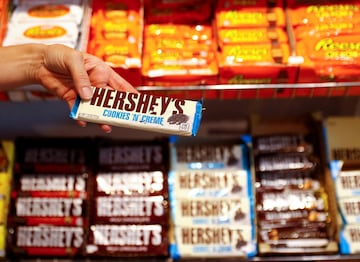SOCIETY
Which chocolates have the highest amount of lead and cadmium?
Some of the brands manufacturing the delicious cocoa treat have products containing metals, as revealed by a recent American study.

Chocolate is a highly diverse food, from its flavours to its textures. It can be melted with fruit, used as an accompaniment to ice cream, or simply bitten direct from a bar. In any case, it is a way to enjoy a meal, although its consumption needs to be monitored, as when it comes to the cocoa delight, indulgence can come all too easily, and we know that excessive intake can be detrimental to one’s health.
The benefits and quantity of chocolate
Of course, the fabulous news is that responsible and moderate consumption of this food can contribute to our well-being, as it has anti-inflammatory and prebiotic effects, and it can have a positive impact on our immune system. For this purpose, the recommended amount is between 10 and 30 grams per day, equivalent to 1 or 2 ounces/spoonfuls.

Reminders are constant, however, about moderation, with experts such as those at the clinic Quirónsalud advising us to take care and not succumb to our hunger desires.

Are some chocolates dangerous?
Then there are the other dangers, and according to a study by Consumer Reports published in the magazine of the US Consumer Union, some chocolate bars may contain high levels of lead and cadmium, two heavy metals that pose a direct threat to our physical health. This risk can be particularly elevated in pregnant women and children, as it can impair cognitive development, the child’s growth, and the formation of the baby’s brain.
Based on the report, here is a list of chocolates with significant levels of lead and cadmium:
Cadmium
- Beyond Good - 70% Pure Organic Dark Chocolate: 42% lead and 112% cadmium
- Beyond Good - 80% Pure Organic Dark Chocolate: 42% lead and 138% cadmium
- Equal Exchange - 80% Extra Dark Organic Chocolate: 45% lead and 120% cadmium
- Lindt Excellence - 70% Dark Chocolate: 48% lead and 116% cadmium
- Scharffen Berger - 82% Extra Dark Chocolate: 49% lead and 136% cadmium
- Alter Eco - 85% Organic Dark Chocolate: 49% lead and 204% cadmium
- Pascha - 85% Organic Dark Chocolate: 68% lead and 253% cadmium
- Dove - 70% Dark Chocolate: 74% lead and 112% cadmium
Lead
- Tony’s - 70% Dark Chocolate: 134% lead and 28% cadmium
- Lily’s - 70% Dark Chocolate: 144% lead and 42% cadmium
- Godiva - 72% Dark Chocolate: 146% lead and 25% cadmium
- Chocolove - 70% Dark Chocolate: 152% lead and 60% cadmium
- Lindt Excellence - 85% Dark Chocolate: 166% lead and 80% cadmium
- Endangered Species - 72% Dark Chocolate: 181% lead and 31% cadmium
- Hu Organic - 70% Dark Chocolate: 210% lead and 56% cadmium
- Chocolove - 88% Dark Chocolate: 240% lead and 83% cadmium
- Hershey’s - Sweet Dark Chocolate: 265% lead and 30% cadmium

Avoid 0% added sugar chocolate
With all this in mind, guidance from Quirónsalud recommends natural cocoa powder and, if consuming chocolate bars, those with cocoa content above 80%, depending on the brand.
Furthermore, the same clinic advises against buying products with labels that claim “0% added sugars,” as they are often substituted with artificial sweeteners that can harm intestinal microbiota.





